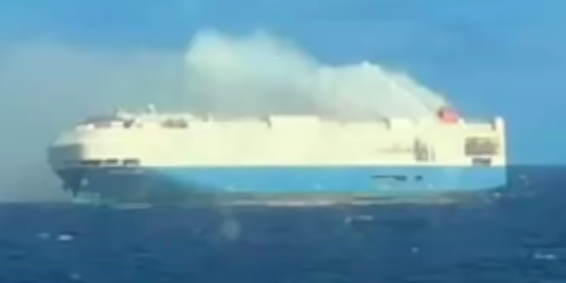Fire on Cargo Ship Packed With Porsches and VWs Is Reportedly Fueled by EV Batteries

Electric vehicles aboard the abandoned, burning cargo ship in the Atlantic ocean may be complicating efforts to control the blaze, a new report from Reuters says.
Putting out the fire on the Felicity Ace won't be easy. Maritime regulations require automotive shippers to drain the fuel tanks of vehicles in transit, but U.S. law allows 17 ounces (500 mL) of fuel to remain in each car, including anything in the combustion chamber, fuel lines, and tank. That reduces the risk of fuel catching fire, but when there's another ignition source—like the time a recalled Ford's wiring shorted out in transit—the tightly-packed cars offer lots of flammable material if a sufficiently hot fire develops.
This kind of precaution has no equivalent in EVs. And as The Verge reports, the roughly 4000 cars onboard include an unknown number of Audi E-Tron Sportback electric utility vehicles. The reality is worse now that we know EVs are on board the Felicity Ace, as Reuters explains:
Lithium-ion batteries in the electric cars on board have caught fire and the blaze requires specialist equipment to extinguish, captain Joao Mendes Cabecas of the port of Hortas said.
Once ignited, a lithium-ion battery is incredibly difficult to extinguish. At first, fire damages the structures that separate the chemicals that power a battery. This often leads to spontaneous re-ignition even after the initial blaze is out. Hundreds of gallons of water are often required, and once the initial fire is out, standard procedure is to quarantine the affected vehicle away from anything flammable, applying more water or fire suppressant as needed. Fire crews sometimes place a burning battery inside a giant water tank until the re-ignition risk subsides.
Neither option is viable on a crowded transport ship. Even if you had a dunk tank or were willing to deal with the environmental consequences of throwing the vehicle overboard, there's usually no way to maneuver or eject the cargo on a ship en-route. Burning cars weighing thousands of pounds and spewing toxic fumes would prove even more difficult to handle.
The answer at this point is likely to wait it out. Captain Cabeças told Reuters "the ship is burning from one end to the other... everything is on fire about five meters above the waterline." All cargo, then, is already doomed. The crew is evacuated, the ship is still floating, and authorities are monitoring the abandoned vessel to make sure it doesn't collide with anything. There's not much more they can do until the fire burns out.
We've reached out to Audi to see what precautions are used to mitigate EV fire risk during ocean transit, and how they differ from standard ICE procedures. We'll update if we hear back.
You Might Also Like

 Yahoo Autos
Yahoo Autos 